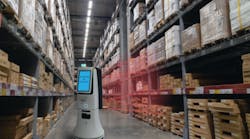By Gopal Mitra, industrial segment leader at ABB Power Conversion
Fully autonomous warehouses are gradually breaking onto the manufacturing and retail scenes, driven by advances in automation and shortages in the labor market. Technology is enabling robots to handle tasks once capable only by humans.
Widespread adoption is still likely years away, as the upfront cost of implementation often outweighs the potential long-term financial and logistical benefits. The successful growth of this model will hinge on the ability to boost power density and data-transfer speeds to support low-latency communication and cost-effective operations.
What is a dark warehouse?
Fully autonomous warehouses are often referred to as “dark” because of the minimal-to-no human intervention and lack of lighting needed to operate them. In facilities where robots run the show, lighting and temperature needs are specific to product stability only. As such, e-commerce giants and other logistics organizations can improve their return-on-investment by mitigating cost variables.
Additionally, dark warehouses can offer benefits like better efficiency and faster processing of goods, which in turn can result in higher profit margins. However, the upfront infrastructure costs can hinder cash-strapped budgets. While automation can offer cost savings in the long run, many technological investments are necessary, with particular focus on power infrastructure and innovative charging capabilities.
Automation and the supporting foundation associated with these facilities require considerable investments in power infrastructure. For example, seamless monitoring and command functions will need increased power capability in board-mounted power-conversion products. Power-dense on-board batteries will keep the robots running, while charging stations will allow unused power to be recycled back into the grid. Advancements in 5G networks with high bandwidths will deliver speedy communication and high-capacity data transfers among robotic workers and integrated warehouse management software-based control systems.
Robots are hungry for power
For complete autonomy, robotic systems of the future will require reliable and robust power supplies and networks with low latency to enable communication with each other, and for off-site monitoring and troubleshooting. Self-charging and reliable onboard batteries, despite their compact size, will need to deliver high-power density to robotic components without overcharging, as well as backup systems that can rely on unused energy stored in the batteries of inactive robots. Power engineers in this space look to emerging technologies such as wireless charging to combat these operational-efficiency challenges. Contact-based charging, on which the majority of automized warehouses rely, causes downtime due to the need for human oversight for plug-ins and maintenance of ports and cords.
On the other hand, fully autonomous warehouses that utilize wireless charging can mitigate downtime through close-coupling induction. This technology creates efficient power transfers that allow up to a quarter inch of space between the charging station and the robot while providing approximately 90% efficiency.
There are significant power-density considerations
As technology becomes more sophisticated, devices are becoming smaller. Power demands continue to grow despite shrinking footprints, and fitting more power into less space is an ever-evolving challenge for design engineers. Modular DC/DC converters, for example, deliver high-power densities and can save engineers board space, offering an integrated alternative to discrete designs. Modular designs are able to help reduce points of failure on boards and optimize functionality and performance.
Human oversight will likely always play a role
No matter how self-aware robots become, they will likely always require human interaction for maintenance and troubleshooting. Until technology allows for self-correction, oversight will be required to help ensure safety, maintenance and control measures. Programming errors can cause collisions, and robots lack human qualities like prior experience and ethics to make decisions and solve problems without interruption. For instance, a conveyor belt can break, or a sorter robot can suffer a glitch, causing a hiccup that results in a significant mishap downstream.
The value to an automated approach
In the end, companies in more industries will see value in employing fully automated warehouses as labor costs, shortages and supply chain difficulties continue to drive the need for mechanization. From an enterprise level, connected robots can offer savings, while advanced analytics may provide real-time predictive data that helps stakeholders minimize risks and reduce costs.
While there are several significant power challenges hindering the widespread adoption of fully autonomous warehouses, it’s reasonable to conclude that enterprises will one day see significant return-on-investment from their use. However, with continued advancements in charging infrastructure and power capabilities, a fully autonomous warehouse future may be closer than once imagined.


